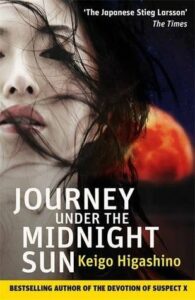 Journey Under the Midnight Sun by Keigo Higashino
Journey Under the Midnight Sun by Keigo Higashino Translator: Alexander O. Smith
on October 9, 2015
Source: Gift
Genres: Crime Fiction, Mystery
Pages: 539
Format: Paperback
Purchase at Bookshop.org
Add on Goodreads

This is the compelling story of a brutal crime and the two teenagers—Ryo, the son of the murdered man, and Yukiho, the daughter of the main suspect—whose lives remain inextricably linked over the twenty-year search for the truth behind the crime.
In Osaka in 1973, the body of a murdered man is found in an abandoned building. Investigating the crime, Detective SasagakI is unable to find the killer. Over the next twenty years, through the lens of a succession of characters, Higashino tells the story of two teens, Ryo and Yukiho, whose lives are most affected by the crime, and the obsessed detective, Sasagaki, who continues to investigate the murder, looking for the elusive truth.
Journey Under the Midnight Sun is a complex, psychological novel about crime and its after-effects by one the most read and most accomplished contemporary mystery author. A twisting, compelling work that will astonish and delight Higashino’s old fans and new readers alike.
Journey Under the Midnight Sun is compelling and clever and not a typical mystery. A pawnbroker is found murdered in an abandoned building in Osaka in 1973. Detective Sasagaki is assigned to the case. He uncovers a lot of clues and possible suspects but is never able to charge anyone with the crime. The case reaches a dead end and Sasagaki is forced to give up his investigation. However, he continues to keep tabs on the two pre-teens involved in the case the daughter of Fumiyo Nishimoto: Yukiho, the daughter of a woman suspected of having an affair with the pawnbroker, and Ryo Kirihara, the dead man’s son. We see how the crime affects their lives through the next 20 years.
The story is told from multiple points of view, mostly minor characters’, letting us learn about the events and Yukiho and Ryo from various perspectives, but never from their viewpoint. A lot of characters get introduced, some of whom only appear briefly, but it all eventually comes together and the whole picture slowly forms. Following the timeline, we also get to see all the changes along the way in Japan in the technology and economy, even movies. Society is not free from blame here.
It’s a complex, slow-building book and I’m sure I missed several details along the way, details that Sasagaki picked up. Some people will find the ending a bit unsatisfying, but I thought it fit the whole feel of the book well. Overall, I thoroughly enjoyed it, if enjoy is the right word when talking about this kind of book.
Reading this book contributed to these challenges:
